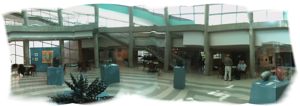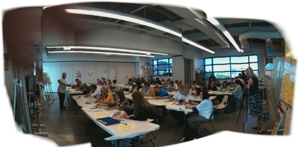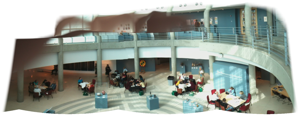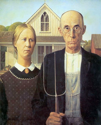 |
 |
 |
|
I’ve also been having fun with a couple of iPhone apps that I downloaded during my three-hour layover in Dallas the other day. With “360Panorama” a can basically use my iPhone like a paint brush, swiping it across and around the image that I want to photograph, unlimited by a single framing of the camera. Fun!
[Click to enlarge the images]
|
I enjoyed working with Art teachers yesterday from across Iowa as well as a smattering of folks from Nebraska and South Dakota. I did the keynote described in my previous blog post and also a session on personal learning networks, which I will be repeating this morning. When my breakout was over, at 4:00, I was talking to a couple of teachers and taking my time disconnecting my computer, when a woman came up and very politely slide here MacBook Pro next to mine. It hadn’t occurred to me that the next presenter would be needing the projector and speakers. This was an Art teachers’ conference after all. Shame on me!
I disconnected and slid my computer and adapters over to the far side of the table so that I could pack them up as she continued to expertly set up her Mac and a colleague arranged various matted art works on other tables — the sort of thing I was actually expecting. The presenter was Ronda Sternhagen and her session was entitled Art and the Evolution of Mass Media.
I had scanned the program the night before selecting session that I might attend, and knew that there was one just after mine that interested me and that it had something to do with mass media — and although I was quite tired by then and had every intention abandoning that plan and heading back to my room to resting before a long walk around Sioux City, I chose to stay and rest in the back of that presentation room.
Sternhagen introduced her topic as the focus of her masters thesis, which she held up fairly close to her heart. It had been an ongoing theme in her family where she got her children in the habit of pointing out major works of art that appeared in the mass media, (magazines, TV commercials, etc.) and try to explain why those works had been selected.
This approach to art instruction evolved into a course, which she described. The process that emerged had students, among other things, select major works of art and then photoshop themselves into the works. They also looked at how some art work was used to promote social issues, American Gothic being a favorite. This approach had such and impact on some of the other teachers and on the principal, that she will be team-teaching with one of the social studies teachers this year, finding ways to integrate works of art in to history and other social studies.
I was blown away by the presentation, which is saying a lot. I got a lot of take-away ideas from it. But I also walked out with two take-beyonds — which are different from take-aways, because they are ideas that I heard, that the presenter didn’t actually say (at lease I don’t remember here saying them).
Sternhagen, as she described these engaging activities and told stories about how the student responded, kept concluding that these techniques were great ways to help her teach art. What I heard was that her students were learning great ideas from history by working the art. When students take a specific work of art, and then photoshop it to illustrate some social (or scientific or mathematical) issue, then this production of media campaign becomes an avenue for exploring deeper curriculum issues.
The other take beyond was this idea of her team teaching with a social studies teacher. Social issues are easy. Might she team teach math, by integrating works of art into math instruction, or science, or literature, or literacy? Might she not become the school’s art integrationist? Would that be of benefit the entire school? My answer? Heck yea! She’d be a huge boost to the entire school. She might even be of more benefit than a tech integrationist.
But! Why not a literature integrationist? Or a literacy integrationis? ..or a math integrationist?
What I can’t shake is that this all seems to be pointing to a radically different arrangment of professional staff in our schools, and a different model for how teachers work together — a model that represents an antithesis of how teaching and learning is arranged in traditional schooling?
What do you think? And if you agree, what might that model look like?









